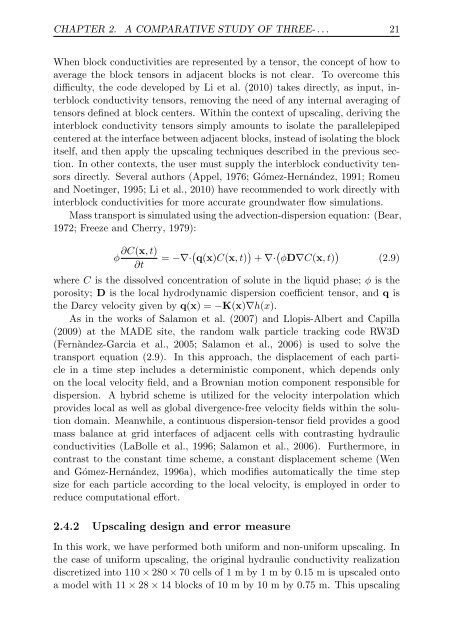Upscaling and Inverse Modeling of Groundwater Flow and Mass ...
Upscaling and Inverse Modeling of Groundwater Flow and Mass ...
Upscaling and Inverse Modeling of Groundwater Flow and Mass ...
Create successful ePaper yourself
Turn your PDF publications into a flip-book with our unique Google optimized e-Paper software.
CHAPTER 2. A COMPARATIVE STUDY OF THREE- . . . 21<br />
When block conductivities are represented by a tensor, the concept <strong>of</strong> how to<br />
average the block tensors in adjacent blocks is not clear. To overcome this<br />
difficulty, the code developed by Li et al. (2010) takes directly, as input, interblock<br />
conductivity tensors, removing the need <strong>of</strong> any internal averaging <strong>of</strong><br />
tensors defined at block centers. Within the context <strong>of</strong> upscaling, deriving the<br />
interblock conductivity tensors simply amounts to isolate the parallelepiped<br />
centered at the interface between adjacent blocks, instead <strong>of</strong> isolating the block<br />
itself, <strong>and</strong> then apply the upscaling techniques described in the previous section.<br />
In other contexts, the user must supply the interblock conductivity tensors<br />
directly. Several authors (Appel, 1976; Gómez-Hernández, 1991; Romeu<br />
<strong>and</strong> Noetinger, 1995; Li et al., 2010) have recommended to work directly with<br />
interblock conductivities for more accurate groundwater flow simulations.<br />
<strong>Mass</strong> transport is simulated using the advection-dispersion equation: (Bear,<br />
1972; Freeze <strong>and</strong> Cherry, 1979):<br />
∂C(x, t)<br />
ϕ = −∇·<br />
∂t<br />
( q(x)C(x, t) ) + ∇· ( ϕD∇C(x, t) )<br />
(2.9)<br />
where C is the dissolved concentration <strong>of</strong> solute in the liquid phase; ϕ is the<br />
porosity; D is the local hydrodynamic dispersion coefficient tensor, <strong>and</strong> q is<br />
the Darcy velocity given by q(x) = −K(x)∇h(x).<br />
As in the works <strong>of</strong> Salamon et al. (2007) <strong>and</strong> Llopis-Albert <strong>and</strong> Capilla<br />
(2009) at the MADE site, the r<strong>and</strong>om walk particle tracking code RW3D<br />
(Fernàndez-Garcia et al., 2005; Salamon et al., 2006) is used to solve the<br />
transport equation (2.9). In this approach, the displacement <strong>of</strong> each particle<br />
in a time step includes a deterministic component, which depends only<br />
on the local velocity field, <strong>and</strong> a Brownian motion component responsible for<br />
dispersion. A hybrid scheme is utilized for the velocity interpolation which<br />
provides local as well as global divergence-free velocity fields within the solution<br />
domain. Meanwhile, a continuous dispersion-tensor field provides a good<br />
mass balance at grid interfaces <strong>of</strong> adjacent cells with contrasting hydraulic<br />
conductivities (LaBolle et al., 1996; Salamon et al., 2006). Furthermore, in<br />
contrast to the constant time scheme, a constant displacement scheme (Wen<br />
<strong>and</strong> Gómez-Hernández, 1996a), which modifies automatically the time step<br />
size for each particle according to the local velocity, is employed in order to<br />
reduce computational effort.<br />
2.4.2 <strong>Upscaling</strong> design <strong>and</strong> error measure<br />
In this work, we have performed both uniform <strong>and</strong> non-uniform upscaling. In<br />
the case <strong>of</strong> uniform upscaling, the original hydraulic conductivity realization<br />
discretized into 110 × 280 × 70 cells <strong>of</strong> 1 m by 1 m by 0.15 m is upscaled onto<br />
a model with 11 × 28 × 14 blocks <strong>of</strong> 10 m by 10 m by 0.75 m. This upscaling


